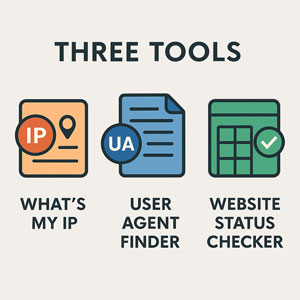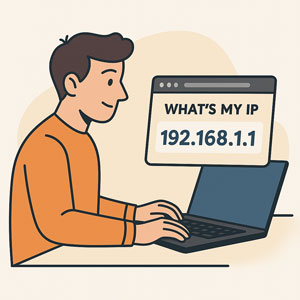
31
Mastering Essential Web Tools: What’s My IP, User Agent Finder & Website Status Checker
Discover how to use three essential web tools-what's My IP , User Agent Finder , and website status checker-to enhance security, optimize performance, and improve your browsing experience.
Unveiling the Power Trio: What’s My IP, User Agent Finder & Website Status Checker
In today’s digital age, understanding your online footprint and monitoring website performance is crucial. Whether you're a developer, digital marketer, or casual internet user, having the right tools at your fingertips can make all the difference. This guide explores three essential utilities—What’s My IP, User Agent Finder, and Website Status Checker—to help you improve your browsing experience, enhance security, and troubleshoot network issues like a pro.
1. What’s My IP: Your Digital Identity
What is it?
“What’s My IP” is a simple yet powerful tool that displays your public IP address—the unique identifier assigned to your device on the internet.
How it works:
The tool instantly detects your IP address, often showing extra details like your ISP name, approximate location, and sometimes your device type.
Why it matters:
- ✅ Troubleshooting: Diagnose network connectivity issues.
- ✅ Security Check: Confirm if your VPN or proxy is hiding your real IP.
- ✅ Geo-Restriction: See if you can access region-specific content.
- ✅ Website Administration: Block suspicious IPs or monitor traffic.
How to use:
Simply visit any trusted “What’s My IP” tool online—no setup needed.
2. User Agent Finder: Revealing Browser Details
What is it?
Your User Agent String identifies your browser, operating system, and device type to websites. A User Agent Finder reveals this string.
Why is it useful?
- ✅ Website Compatibility: Developers test sites on different browsers.
- ✅ Debugging: Fix browser-specific display issues.
- ✅ Content Optimization: Deliver tailored experiences based on browser.
- ✅ Security Analysis: Detect fraudulent user agents.
Example of a User Agent:
Mozilla/5.0 (Windows NT 10.0; Win64; x64) AppleWebKit/537.36 (KHTML, like Gecko) Chrome/91.0.4472.124 Safari/537.36
How to use:
Visit a User Agent Finder website, and it will automatically display your browser details.
3. Website Status Checker: Is the Site Up or Down?
What is it?
This tool checks if a website is online and responding correctly. Perfect for troubleshooting downtime.
Common HTTP Status Codes:
- ✅ 200 OK: Website is live.
- ❌ 404 Not Found: Page doesn’t exist.
- ⚠ 500 Internal Server Error: Server issue.
Benefits:
- ✅ Quickly see if a site is down for everyone or just you.
- ✅ Monitor uptime for your own websites.
- ✅ Diagnose DNS and server issues.
How to use:
Enter the website URL, click “Check,” and the tool displays its status.
Practical Use Cases
- Can’t access a site? Use Website Status Checker to confirm if it’s down globally.
- VPN check: Use What’s My IP to verify your VPN mask.
- Website development: Test compatibility with User Agent Finder.
Ethical Use
Always use these tools responsibly. Avoid malicious practices or violating privacy policies.
Conclusion & CTA
By mastering What’s My IP, User Agent Finder, and Website Status Checker, you gain control over your digital presence, troubleshoot issues efficiently, and optimize your online experience.
Ready to explore these tools? Try them now and make the web work for you!
✅ FAQs
Q1: What’s an IP address?
It’s your device’s unique identifier on the internet.
Q2: How can I hide my IP?
Use a VPN or proxy service for privacy.
Q3: Why does my User Agent matter?
It affects how websites display and function on your browser.
Q4: Can a Website Status Checker fix errors?
No, it only diagnoses if the site is up or down.
Contact
Missing something?
Feel free to request missing tools or give some feedback using our contact form.
Contact Us


